10 Malaise Era Milestones to Silence the Haters

There’s something to be learned from any time period, even one as universally disliked as the Malaise Era (circa 1973–83). The number of innovations and popularizations that improved our lives during this era is astounding, and neglecting them in a modern car would doom that vehicle to mass-market failure. So let’s get the obligatory Ricardo Montalbán TV commercial out of the way, as Malaise Era marketing campaigns were schmaltzy, unforgettable, and almost mandatory at this point.
Now that the low-hanging fruit has been picked, let’s consume the good stuff from the Malaise Era. One could even consider these as milestones, examples of American Exceptionalism. Indeed the USA was embracing change while other countries either feared to embrace it or chose not to provide the fruits of such undertakings. That’s especially true in one particular initiative, which we must put as the first milestone in our series:
Milestone #1: Clean Air in Cities
As our population increased, the number of automobiles suddenly became a black eye for our society. And the rudimentary additions to cars of the 1960s like positive crankcase ventilation and air pumps weren’t cutting the mustard. Breathing smog in the air takes a shocking toll on your body, but don’t take my word for it: Visit a city that only recently adopted emissions controls, and your lungs/eyes/nose will make the fact clear.
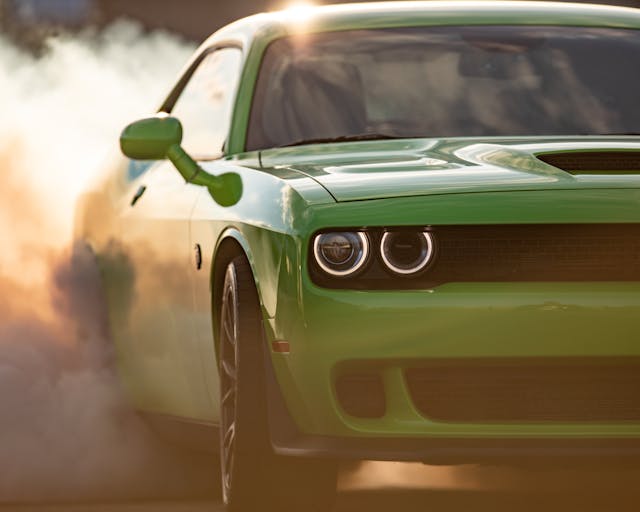
While the first two decades of catalytic converters would hold back ultimate power for those looking for serious engine upgrades, modern powerplants like Chrysler’s Hellcat prove that catalytic converters let you have your cake and eat it too.
Milestone #2: Luxury for the Masses
The personal luxury genre started in the 1960s with the likes of the Cadillac Eldorado, Continental Mark III, and even ritzy versions of pony cars (looking at you, Mustang Pony interior package). But those efforts pale in comparison to what we got in the Malaise Era. Because if you could afford a bit more than a new 1975 Pinto or Vega, well, you just got yourself a first-class ticket to Brougham-town.
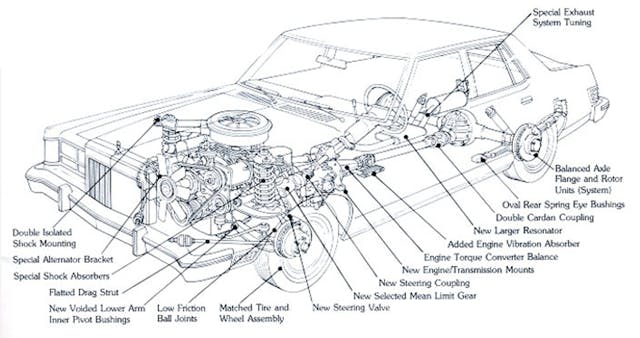
While the Brougham name became the butt of many a car enthusiast’s joke, the added luxuries were underscored with superior noise/vibration/harshness (NVH) reduction techniques: For starters, asphalt-lined sound insulation and thicker interior materials from carpets to door panels. The Lincoln Versailles above was the best and worst example of Malaise Era NVH engineering: It possessed significant upgrades from the era but a pathetic amount of parts was shared with its Ford stablemate.
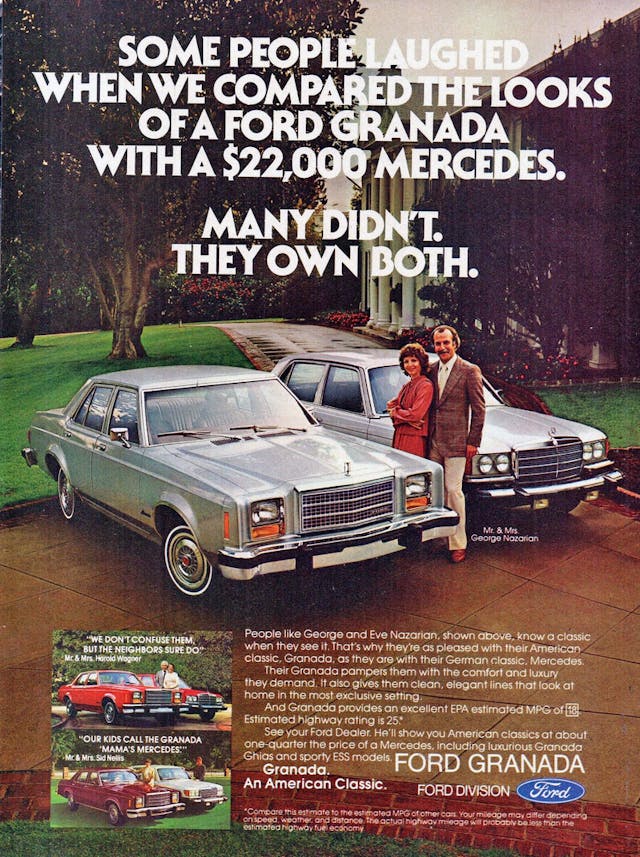
Speaking of Granada, Ford had the audacity to compare its new-for-1975 compact to a Mercedes-Benz W116. How on earth can something based on a 1960 Falcon platform, with a Falcon-derived engine and a stick axle, possibly be on the same level as a German flagship?
It clearly was not, but the Granada cost a reasonable $3800 for a base model. Even in full poverty-spec, the Granada had the telltale signs of a more premium vehicle from Germany or England, right down to the hood ornament, extensive chrome trimming, and an upscale interior with reclining seats, fake wood, and plush carpeting. We may pan Ford for its personal luxury references, but Chrysler (Dodge Aspen) and the fourth-generation Nova did the same thing.
Chevrolet bestowed significant NVH improvements upon the Nova in 1975, and the more upscale versions (LN and Concours) matched the, ahem, luxury of the Ford Granada. (The base 1975 Nova was about $800 less than a Granada.) And this Euro-centric commercial proves that General Motors was drinking the same personal luxury Kool-Aid as Ford.
Milestone #3: Lighter Land Yachts
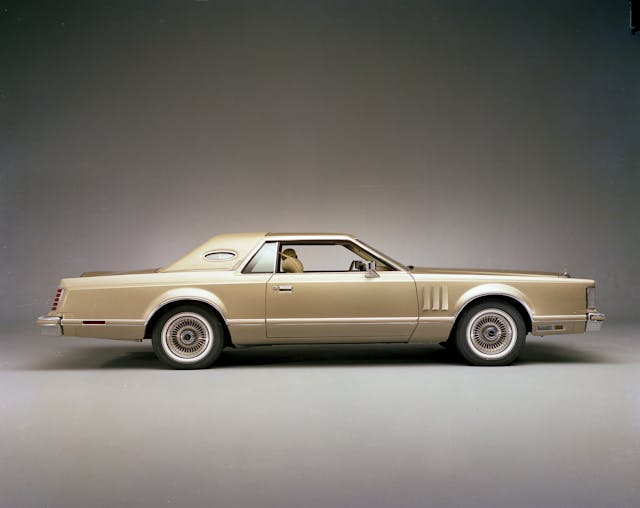
The 1977–79 Continental Mark V might be the only vehicle that’s both larger and lighter than its predecessor. While it’s a mere 2 inches longer, a 502-pound weight reduction is nothing to sneeze at.
The quarter-ton weight reduction came from heavy use of plastics in places you can see, like the revised plasti-fake wood trim, and the lightweight plastic/fiberglass front fascia holding its massive metal grille. But what amazed me was the weight reduction found in places your eyes shall miss.
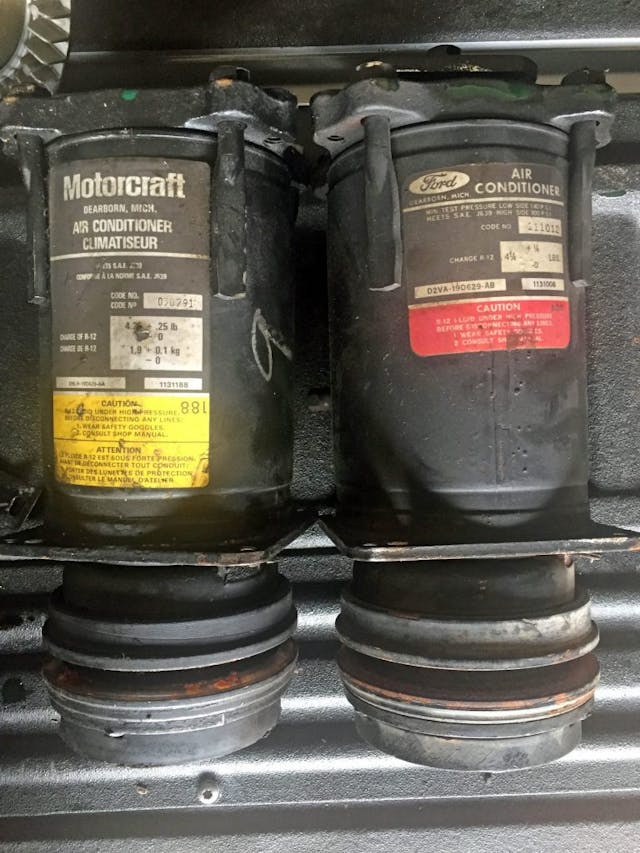
I own and restore both a Mark IV and a Mark V, and the best example of weight reduction that I’ve found are the respective A/C compressors. They may look the same externally, but the Mark V’s unit is roughly half the weight. My personal musings point to a broader trend: Malaise Era engineers were doing some heavy lifting (sorry) behind the scenes to make automobiles lighter. Or perhaps to offset the weight from those big bumpers?
Milestone #4: Bumpers That Bumped Back
For decades, Detroit designers treated the bumper as a mere styling feature, with body-hugging shapes and preposterous dagmars. The Malaise Era was a wake-up call for bumpers, getting them back to prewar duties of actually protecting the vehicle from damage. While the 1973 Pontiac Grand Am wasn’t the first car with the brand’s Endura nose, it proved the concept worked for legislation that required bumpers to become functional once more.
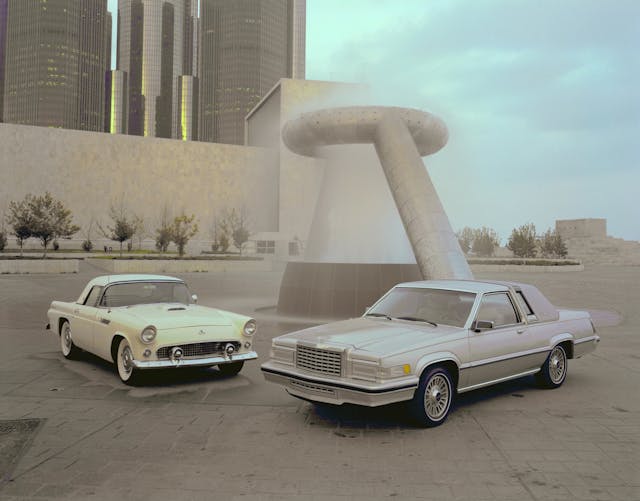
The plastic bumper had a future, as seen in the 1980 Ford Thunderbird. While this is one of the least desirable ‘birds of all time, its wrap-around bumper was trimmer than most chrome affairs and could still pass the second phase of bumper regulations that upped the damage threshold from 2.5 to 5 mph.
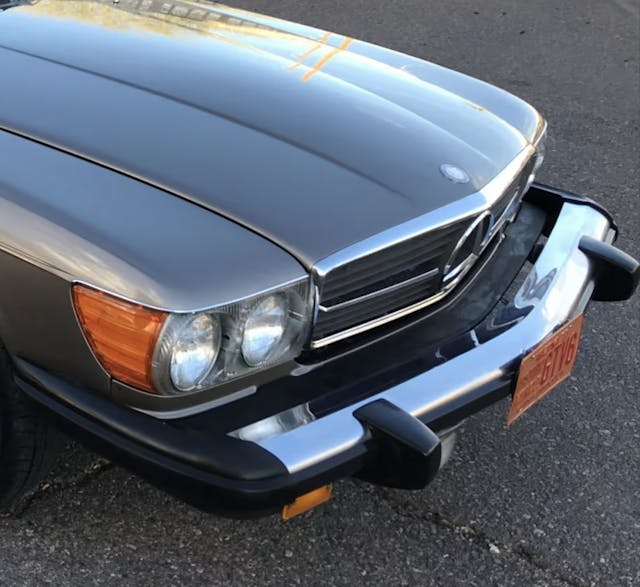
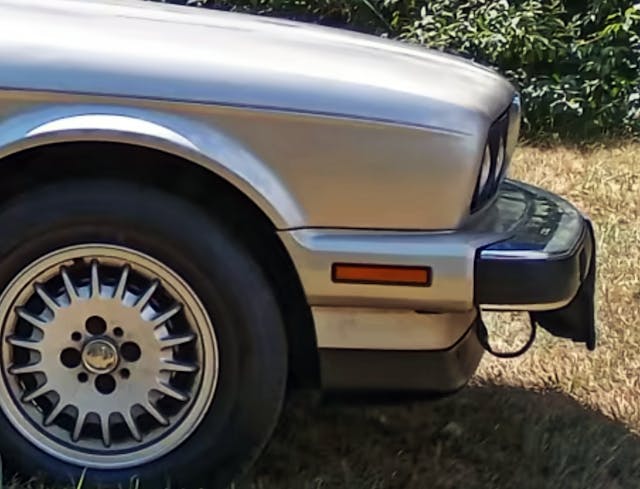
And what was the rest of the world doing? Behold the flagship Mercedes SL roadster, and Yuppie-level luxury BMW E30: Running around with battering rams years after the 1980 Thunderbird. But credit must be given to the 1982 Audi 5000, as its Thunderbird-like bumpers clearly pulled ahead of those worn by its German competitors.
Milestone #5: Adoption of Radial Tires

While the 1970 Continental Mark III (not from the Malaise Era) was the first American car with radial tires as standard equipment, Pontiac made a big deal about the benefits of radial tires in 1974 with its Radial Tuned Suspensions (RTS) for more affordable vehicles.
The radial tire’s softer ride (more sidewall flex), longer tread life, and lower rolling resistance made it the right move over the now antiquated bias-ply rubber. Tire manufacturers (save for the Firestone 500 debacle) wisely made the transition, as the writing was on the wall for all passenger cars. And speaking of lower rolling resistance …
Milestone #6: Better Fuel Economy
While much of this effort inadvertently reduced oil pricing shocks from OPEC during the Malaise Era, making lighter, sleeker, and more efficient cars really helped lower fuel bills for American motorists. One of the major improvements of this era was the large-scale implementation of the automatic overdrive transmission.
Ford released its Automatic Overdrive (AOD) transmission in 1980, while GM introduced the 200- and 700-R4 in 1981 and 1982 respectively. Chrysler’s A500 overdrive didn’t hit the streets until 1988, far after the demise of the Malaise Era. Chrysler’s belated efforts were still two years before Mercedes-Benz released the 722.5 overdrive gearbox (1990). While a stunning delay in overdrive implementation, Mercedes did cheat the system via tall axle ratios paired with shorter gears in a non-overdrive gearbox. (My experiences with them were disappointing, especially at less than full throttle.)
Milestone #7: Life-Saving Technology
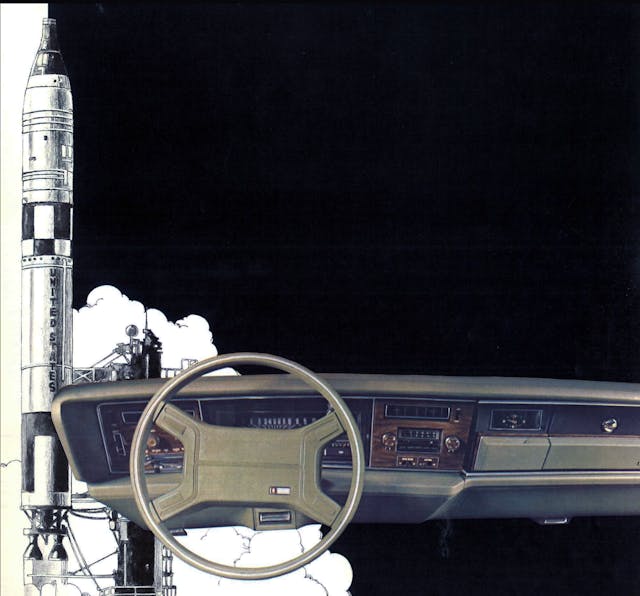
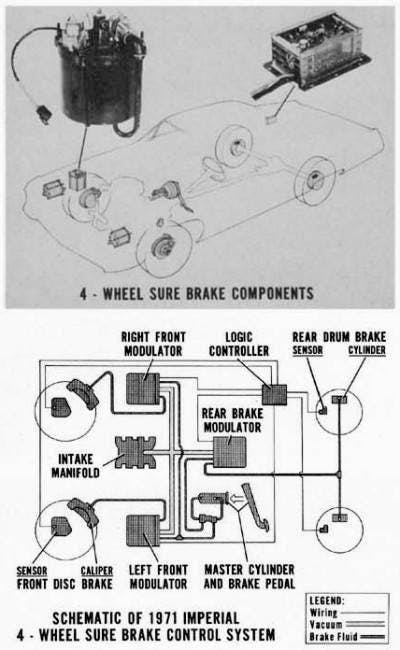
The days of lap belts, padded dash tops, and fully drum-braked vehicles were either gone or disappearing by the start of the Malaise Era. In their place we had three-point seat belts, fully impact-absorbing interiors, and front disc brakes (1975) across the board. It was good for both the future and the past, as countless first-generation Mustangs grabbed the front spindles and disc brakes from the aforementioned 1975 Ford Granada.
But there was much more to this era of automotive safety, as GM introduced the Air Cushion Restraint System (ACRS) in the 1974 Oldsmobile Toronado. (Mercedes was working on a similar system, which it released in 1980.) GM’s ACRS offered the modern airbag experience for driver, passenger, and center passenger occupants, while Chrysler sold the first four-wheel, computerized anti-lock braking system on an American car in 1971. (Yes, that’s technically before the Malaise Era.)
While these advanced safety systems were poorly received and suffered from short production lifespans, the post-Malaise technology boom made them palatable for everyone. Who knows how many lives ABS and airbags have saved in the last 30 years, but we have the Malaise Era to thank for all of them.
Milestone #8: Aerodynamics for All
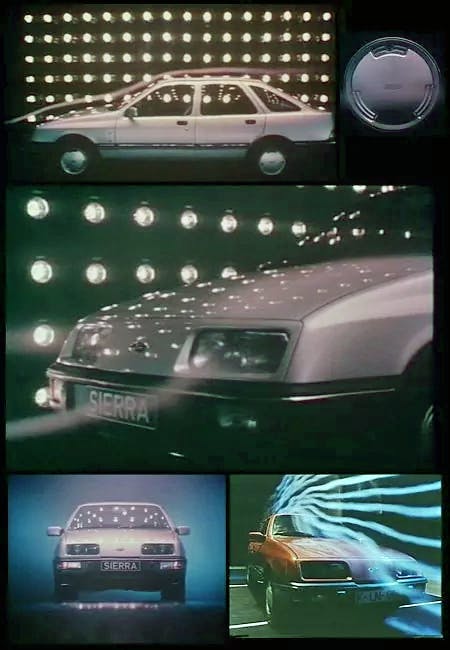

Wind tunnels have shaped cars since the Chrysler Airflow, but things didn’t get serious until Malaise Era demands put fuel economy on everyone’s mind. And one great way to lower fuel economy is to reduce the amount of fuel needed to push a car through the air.
Technology made plastics both lighter and cheaper in this era, quickly turning bumpers into tools for air manipulation. And it was indeed for all, as shown in cheaper cars like the German Ford Sierra (above) and traditional sports cars like the refreshed 1980 Corvette. That C3 Corvette infused front and rear aerodynamic elements from the 1978 Corvette Pace Car, lowering its drag coefficient from an awful 0.503 to a significantly less awful 0.443. (The C4 Corvette was a sleek 0.34, and that engineering technically happened at the tail end of the Malaise Era.)
Finding highway mileage ratings for the 1980 Corvette from the EPA was impossible, but the 1980 car did get an extra mile per gallon in the city over the 1975 model, rated at 13 mpg. Factor in the extra drag at highway speeds and it’s fair to extrapolate an even more significant improvement to the highway fuel economy of the 1980 Corvette; for 1975, that figure was only 20 mpg.
Milestone #9: Computers Outside Academia
Computers were still a flight of fancy in the Malaise Era, though some of us had an Atari 2600 or a Bally Home Library Computer by 1978. While I suspect the would-be Bill Gates of the world weren’t the target market for Cadillac’s Seville import fighter, the hardware that made home computing systems likely interchanged with Cadillac’s Trip Computer. This system showed everything from engine rpm to the Seville’s Estimated Time of Arrival (ETA) to a pre-programmed destination. It’s a great system that actually worked, and today everyone benefits from ETA calculations in our smartphone-based navigation systems.

That Seville also had a Bendix electronic fuel-injection system, but the other two Detroit manufacturers were taking a stab at in-house, in-car computer designs. The Malaise Era system that earned enough goodwill to stand the test of time is likely Ford’s EEC System, now in its seventh generation. The original EEC-I computer lacked the wattage to run more than a handful of sensors (often needing vacuum actuators for operation) but the die was cast, and engine computers were here to stay. Speaking of computers …
Milestone #10: Computer-Aided Design For All
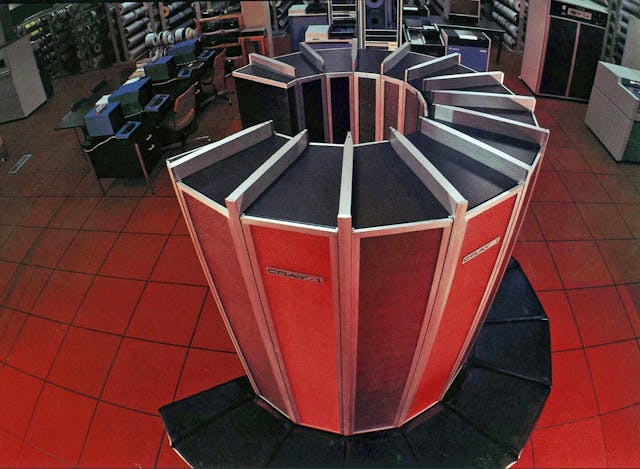
Supercomputers were all the rage in the 1970s, provided you had the millions of dollars needed to buy one. And they allowed for computer-aided design, a topic I previously wrote about that inspired this list of Malaise Era milestones.
Computer modeling opened doors to advanced design concepts like ergonomics, finite element analysis, and aerodynamic and crash-test modeling for all cars. The sheer number of doors opened by computers is impossible to count in our modern society, and I reckon most of those doors were worth opening. The portals pertaining to modern automobile innovations are “must sees,” and we can clearly thank the Malaise Era for bringing computer technology to our beloved automobiles.
So how do you feel about the Malaise Era now?
***
Check out the Hagerty Media homepage so you don’t miss a single story, or better yet, bookmark it. To get our best stories delivered right to your inbox, subscribe to our newsletters.


The article made me think back on the ’73 – ’83 cars I drove/owned:
’73 Volvo 144 – ran terribly thanks to poorly-done emissions controls, plus overall build quality was horrible.
’74 Maverick (with the Luxury Decor Option!) – ran slightly better than the Volvo, but even worse quality. Began rusting through (holes!) in 18 months.
’75 Hornet Sportabout – ran and handled well, decent build quality but very cheap interior materials
’77 Pontiac LeMans 2-door – No complaints really except the frameless door glass weatherstrip self-destructed in short order, had to find new.
’78 Pontiac LeMans Safari – Horrible build quality, ran decent but too may flimsy pieces due to weight reduction taken too far. Plus non-retractible rear windows.
’78 Olds Delta 88 – great car, ran and rode very well, scads of room inside.
’79 Chevy Impala – see the Olds above
’79 Buick Park Avenue – even more room, an equally great car. The downsized GM B and C-bodies were superb.
My conclusion is that as the era went on the cars improved somewhat in driveability and handling, but build quality got worse due to cheap materials demanded by the finance types.
As someone who got his license in 1975, I often wished I could have started driving in the mid-60s when cars had more flair and were more exciting. I also would probably be dead since the crashes I was in during those first years were serious. Despite what detractors say, you can’t fault cleaner engines, and safer cars, even if they were forced by the government. Are you all seriously mad about those things? As for the government imposed changes today, I suspect that any mandated change-over to EVs will be slower than currently indicated, which is good. Hopefully I won’t live to see it.
In #6 of your article you say the 700R4 was introduced in 1982 I believe you are off by around 6 years. We were still producing the 200-4R in Three Rivers, Mi at that time.
Thanks for bringing this up, I definitely need to mention the 200-R4. But according to Wikipedia and my research of historical materials, the 200-4R came out in 1981, and the 700-R4 was indeed in 1982 (most notably in the last C3 Corvette). If you have proof to the contrary I would love to see it and make that correction.
TH700R4 and TH200R4 were produced simultaneously. 700R4 came out in 1981.
The TH200R4 had a dual pattern for BOP and CPC. It fit in the tunnel of the G-body cars, where the 700 was a little too tight.
200R4 production ended with the last Olds 307.
More Hagerty Click bait , how about advancements in Fuel Injection? Turbos becoming viable after the blow though carb days in the early 60’s . Unleaded gas was a huge boon to reducing smog & illness with an ancillary benefit to a decades decline in violent crime due lead poisoning . Malaise era cars sold like crazy , Mustang II’s were almost 400k strong a number they would kill for today. Yes it was a dark time but Detroit was counting its money an putting band aids on their cars while the Imports were grabbing market share. Without Government intervention we would not have the golden age of automobiles we enjoy today
Leaded Gasoline didn’t cause smog, that was simply a lack of pollution controls.
Catalytic converters and unleaded gas do go hand in hand, and the dangers of lead in the air are real.
The lack of 3 way catalysts and NOx emissions restrictions necessitated low compression, very little spark advance and the notoriously lazy engines.
I had a 75 Pontiac 400 that ran best with 20 degrees initial advance and limit in the mechanical advance to 40 total. It was just hard to start in summer.
I knew this article would bring out the loud people in the room. I’ll take clean air, thank you, and an airbag that will save the life of myself or my passengers. The automakers don’t change unless they’re forced to. Who else is going to do that if not the Feds? I love the land barges from the ’60’s as much as the rest of you, and I own one. If everyone did, I’d be the first to junk mine and suggest everyone else do the same in the interests of living in a better world.
Better is VERY a subjective term.
This is the era I went rogue and fell in love with Saabs. Had a ’70 99 that for almost Maverick money had a 4 spd, 4 wheel disc, OHC, FWD (even frewheeling), comfort for 5 humans. Just a complete and fresh engineering approach versus the 60’s engineering lurking under ever larger and thinner sheetmetal. Could not get into Plastico burl and padded half vinyl roofs.
Infected my family and many friends with the Swede. Yes, later had one of the fabulous Turbos. So sad their auto business was absorbed by the General, and morphed into a rebadged everything.
I’m afraid other than some good looking cars, the malaise era was not a good time to be into American cars.
My 61 year old Studebaker, Avanti has front disc brakes, aerodynamic design, a crash resistant passenger compartment, mostly, with built in roll bar and Mercedes Benz door latches. It was designed and built a decade before the Malaise era and I believe inspired a lot of the innovations that started showing up.
As a former Avanti owner, I agree but I wish some of their innovation had gone towards a more modern transmission (two-speed…really?) and 1953 frame/suspension.
The looks of the car wrote checks the rest of it couldn’t cash.
As far as aerodynamics: Check out the nearly vertical windshield….that’s where it (and the E-type) shows its age.
Put something out there, Lots of folks are going to complain and disagree. So I’ll wear the target for a bit.
1. In my 50 years of driving/car ownership all of the ugly ducks came from the late ’70s through the ’80s
2. The same period gave the most unreliable, from all mfgr’s.
3. Front wheel drive was a boon. A 60 mile, 6 day a week commute in northeast winters was not a problem. LOVED driving by all those 4-wheel drives off in the snow banks. Poo poo if you want I’d take my Reliant K-car back any day above the jelly beans they’re pushing on us for years, now.
4. Speaking of jelly beans, line up similar models from 7 different manufacturers today and the only way you can tell them apart is by studying their badging. Bleh!!
5. And EVs being the savior when our fossil fuels run out. Duh!! Where do you think the majority of juice that comes out of those charger wires comes from?
6. Necessity is the mother of invention. And the author is correct. Hindsight is always 20-20, and yeah, they coulda’ shoulda’ done better, the auto industry did come through being dealt a poor hand and gave us a lot to base future improvements on. You should have been in the tech industry during the same period like I was. Change is good, and often forced. But you can put that mobile phone in your back pocket instead of pulling it along behind you in a roller suitcase.
I thought pretty well everybody hated the Mustang II, and that came out in 1974.
Again, another car hated by those who have never driven one.
They hate it because it’s not a ’69 Mach One….but it was the right car for the time. Look at the sales figures.
Gotta admit I had a 77 Chrysler Cordoba with a 400 4bbl and it went pretty good and sounded good with the air cleaner lid flopped !!!
Radial Tires on American Cars
You said, “While the 1970 Continental Mark III (not from the Malaise Era) was the first American car with radial tires,…” I bought a 1968 Firebird 400 that I specked out with disc brakes and Goodrich Radial tires. Consequently, I couldn’t order the Rallye wheels I wanted. The tires were first generation radials among US makers and I was young enough and foolish enough to try a top-speed run one time. Although it could have been higher because I also ordered a 2.36 rear diff ratio. And, the 3-speed hydramatic only shifted to 3rd at 90 mph. It still had more power to go when I backed off at 135. I look back now and that was dumb. Think about it: a convertible top, first gen radial tires and no roll bar. I was lucky the tires held up.
Sorry for that error, I have adjusted the text to note the Mark III was the first car with radials as standard equipment.
For a guy that was 20 in 1970 the era was definitely a Malaise Era. With chromed railroad ties for bumpers and anemic engines there were very few desirable cars available. For me, anyway. I started reading HotRod in 1967 and so many great cars were featured then, and for a few years more. Then it all cratered.
Many of the changes / innovations back then were the start of things that became more refined and standard. Think back to the 60’s – 100k on your engine and it was usually burning and leaking oil. Spark plugs lasted around 10k. Cup holder was a plastic hook deal you hung on your door.
Emissions drove a lot of change – some good, some not so good. I’m happy the air is cleaner, my mileage is better, and my car handles better.
Some of the cars back then had horrible performance and quality issues. But things like electronic ignition – very unusual before 1973 – paved the way to longer engine life, cleaner emissions, and longer plug life. Distributors disappeared as more sophisticated computer systems were developed. Carbs also went through a similar path – crude at first, then TBI, then multiport injection.
Hate this article or love it – many of the points are well taken by many.
I hated many cars in this era, but appreciate where most of these changes helped get us to. I still would rather row through the gears, unlock my doors with a key, and roll down my windows. But I appreciate cruise control on a long trip, and a car that starts easily no matter what the weather.
Good article. Despite the haters (“haters gonna hate”), it does point out many advances of the 1970’s. Of course, it also points out some dubious items (a Granada compared to a M-B, for example), but overall, it fairly presents these advances.
Thank you for writing this article. People have selective memories and many will refute the facts anyway.
It’s a breath of fresh air.
Thank you catalytic converter as well.
Thank you for reading. Now that you mention it, the whole Malaise Era was a Breath of Fresh Air. 🙂